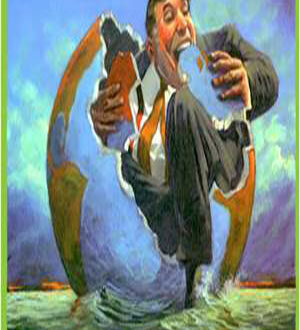From Skype to robotics, our basest instincts have given us our greatest innovations. An expert explains why.
Our lives today are more defined by technology than ever before. Thanks to Skype and Google, we can video chat with our family from across the planet. We have robots to clean our floors and satellite TV that allows us to watch anything we want, whenever we want it. We can reheat food at the touch of a button. But without our basest instincts — our most violent and libidinous tendencies — none of this would be possible. Indeed, if Canadian tech journalist Peter Nowak is to be believed, the key drivers of 20th-century progress were bloodlust, gluttony and our desire to get laid.
In his new book, “Sex, Bombs and Burgers,” Nowak argues that porn, fast food and the military have completely reshaped modern technology and our relationship to it. He points to inventions like powderized food, which emerged out of the Second World War effort and made restaurant chains like McDonald’s and Dairy Queen possible. He shows how outsourced phone sex lines have helped bring wealth to poor countries, like Guyana. And he explains how pornography helped drive both the home entertainment industry and modern Web technology, like video chat. An entertaining and well-research read, filled with surprising facts, “Sex, Bombs and Burgers” offers a provocative alternate history of 20th-century progress.
Salon spoke with Nowak over the phone from Toronto about the importance of the Second World War, the military roots of the Barbie Doll and why the Roomba is our future.
How would you summarize the broader argument behind the book?
It’s a look at some of the darker instincts that we as a race have: the need to fight, the need to engorge ourselves and the need to reproduce. Despite thousands of years of conscious evolution, we haven’t been able to escape those things. It’s the story of how our negative side has resulted in some of our most positive accomplishments.
So much of the technology you talk about came out of the Second World War. Why was that period so important for innovation?
It was when the military really started spending a lot of money on research. At one point during the war, the U.S. was devoting something like 85 percent of its entire income to military spending. So when you take that kind of effort and those resources and that brainpower and you devote them to one particular thing, the effects are going to be huge and long-lasting, which is why World War II was probably the most important technological event in human history. And the sequel, at least technologically speaking, to that period was the Space Race. I’m of the belief that cancer could be cured if somebody in the United States would dedicate the same kinds of resources in the same amount of time as it did to developing the atom bomb and putting someone on the moon.
What kinds of things came out of the war?
The food innovations that happened during the war paved the way for the rest of the 20th century. The U.S. military had to move large numbers of troops over to other parts of the world and then feed them, so a lot of techniques were created and perfected, from packaging to dehydrating and powderizing foods. Powdered coffee and powdered milk came of age during World War II. These advancements in food processing techniques created the foundation of the food plentifulness in the U.S. and created the opportunity for countries to become global food exporting powers.
Plastics are interesting because they — 60 years later it’s hard for us to think about this — but they really revolutionized the way everything was done because materials were running short in every sense during the war. During the war, there was a lot of emphasis put on creating synthetic materials and chemicals. These plastics were used during the war for things like insulating cables or lining drums or coating bullets. Then, after the war, chemical-makers like Dow started to come up with new uses for these things, which translated into everything from Tupperware to Saran wrap to Teflon to Silly Putty to Barbie dolls.
I was surprised to find out that many of our favorite toys, like Silly Putty and Barbie, had their origins in the military.
Silly Putty was developed as a replacement for rubber because one of the biggest suppliers of rubber before the war was the Pacific Islands, which the Japanese army was busy conquering during the war. Most people believe it was invented by someone working for General Electric named James Wright. He came up with this substance that was rubberlike, but the Army eventually decided not to use it because, if you’re familiar with Silly Putty, it’s not the greatest substance for making tires. After the war, he ended up at this toy store in Connecticut, and they packaged it in plastic eggs and kids ended up loving it. It was capable of doing all sorts of things: You could stretch it and plop it down on a newspaper comic and it would take the ink of the comic. It seems like a silly toy now, no pun intended, but back then it was pretty cool.
And Barbie obviously was a product of Mattel, whose founder was very into space-age stuff. He liked all these new plastics and he liked miniaturizing [things], so he went looking for people who could create toys based on this new technology. He found this guy named Jack Ryan who was an engineer for Raytheon, the missile builder. He worked on missiles for them, but Mattel lured him over with promise of royalties on anything he invented. They found this doll in Germany or Switzerland based on a newspaper cartoon similar to Blondie, except the main character was apparently a bit of a gold digger so there was a lot of sexual innuendo in the cartoon. Jack Ryan basically redesigned the new doll, and used his miniaturization knowledge to create the joints. He created a new plastic molding process for it so it was softer. And it became the bestselling toy in history. He also helped create the Chatty Kathy doll, which was like a Cabbage Patch doll but they had miniature record players inside them that say pull the string and she said stuff like “I love you,” and he also helped design Hot Wheels.
There’s the widespread belief that porn is responsible for the Internet becoming so successful. How true is that?
It’s true to some extent with most communication technologies. The military is the big creator of new technologies, but we also need early adopters. If you create new technology and nobody uses it or uses money to further develop it, it’s not going to go anywhere. That’s the role the porn industry has historically played, as far back as the film cameras that came out of WWII. Those cameras existed before the war, but nobody really used them. When the war happened, all these troops were trained as semi-professional filmmakers. Their job was to film stuff for training videos and newsreels and propaganda. They standardized all these 8 mm and 16 mm cameras so they were small and their parts were interchangeable and they were easy to use. After the war, you had thousands of troops go into civilian life and some decided to get into moviemaking. A few of them made Oscar nominated movies, like Stanley Kramer, while others such as Russ Meyer, who was a cinematographer for George Patton, basically kick-started the porn industry with his soft-core movies. Once this market was established, a lot of competition started to pour into this genre. You got things like film loop booths in peep show outlets, which evolved into VCRs and camcorders and from there to DVDs and of course the Internet.
 Mouood Mouood English Edition
Mouood Mouood English Edition




